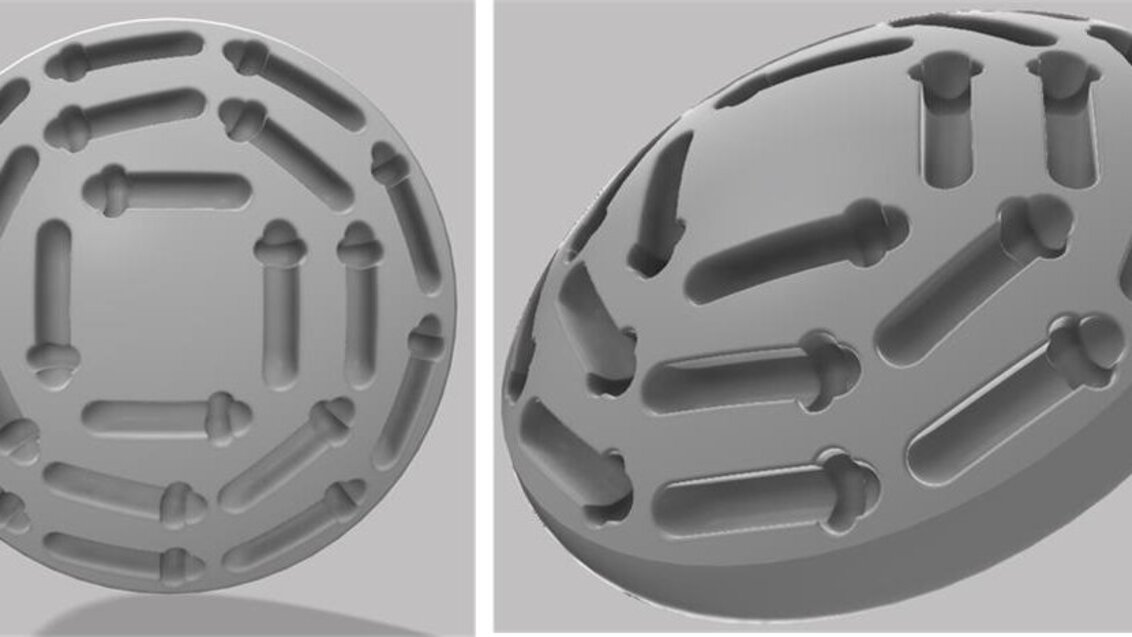
A design of the applicator created by the team of the Department of Biomaterials and Composites (AGH UST) and the University Hospital in Krakow
The AGH UST scientists, together with medical physicists and doctors from the Ophthalmology and Ophthalmic Oncology Clinical Department of the University Hospital in Krakow, have developed a 3D printing technology of polymer liners for ocular applicators. Similar solutions have been used in the treatment of intraocular tumours, including a malignant eye tumour – choroidal melanoma.
The concerted cooperation between the AGH UST and the University Hospital in Krakow has been going on uninterruptedly for more than a year. The impulse to act for the two research teams has been the shortage of medical materials on the market and problems with the delivery of liners for ocular applicators. The situation made treating patients suffering from ocular cancer quite challenging and the only efficient therapy currently applied in Poland (95% effciency) impossible to implement regularly. The aim of the team of doctors, medical physicists, and material engineers was to create their own repetitive technology for manufacturing polymer liners in the shortest time possible, to become independent of external suppliers, and to improve the properties of the polymer liners. Concurrently, they wanted to immediately implement the invention in the treatment of ocular tumours at the University Hospital in Krakow.
The solution is an effect of the cooperation of teams from the Faculty of Materials Science and Ceramics and the Ophthalmology and Ophthalmic Oncology Clinical Department of the University Hospital in Krakow. As a result of the joint work, scientists were able to implement the 3D printing technology of polymer liners for ocular applicators. Such devices have been used in intraocular tumour treatment, including a malignant eye tumour – choroidal melanoma. The polymer liner facilitates permanent placement of radioactive granules of iodine isotopes in the ocular applicator, making irradiation of the intraocular tumour extremely precise, repetitive, and, above all, effective.
Treatment with the use of ocular applicators, commonly applied for many years, is based on the appropriate location of the tumour in the eyeball, the attachment of the applicator to the surface of the eyeball for the time determined by medical physicists and doctors, and finally the removal of the applicator.
‘Our job was primarily to develop a polymer applicator that could be quickly implemented in therapy and meet all the requirements‘, explains Dr (Eng.) Piotr Szatkowski from the Faculty of Materials Science and Ceramics.
In the first stage, a project was created of a currently used applicator that considered and improved the geometry of the grooves for the iodine granules and modified the leakproofness of the applicator itself. An appropriate production method has been selected, a 3D printing technique chosen, and a material determined that meets the strict criteria for medical applications. Using 3D printing technology makes it possible to create projects that can be adjusted to the size of the neoplasm, leading to a fully personalised treatment process in the future.
‘The material from which the liners are printed is dedicated to medical applications. The possibilities that 3D printing technology provides make the University Hospital in Krakow independent of market fluctuations and the availability of polymer liners in Poland and abroad. Our hospital has acquired a suitable printer and began printing the tailor-made polymer liners developed by scientists. The cooperation that we established shows the way to make use of the high scientific potential and scientific implementation of a project for clinical applications in a short time‘, explains Professor Bożena Romanowska-Dixon.
‘The efficiency of brachytherapy with 125I (iodine isotope) in the treatment of intraocular cancer, including uveal melanoma, is extremely high, it exceeds 90% and can be compared with proton therapy’, specifies Professor Bożena Romanowska-Dixon.
The implant for treating eye cancer has been created through the cooperation of a research team from the Faculty of Materials Science and Ceramics (Department of Biomaterials and Composites) led by Dr hab. (Eng.) Kinga Pielichowska, Associate Prof. at the AGH UST (the team: Dr (Eng.) Piotr Szatkowski and Rafał Twaróg, Eng.) and the Ophthalmology and Ophthalmic Oncology Clinical Department of the University Hospital in Krakow represented by the team of Prof. Bożena Romanowska-Dixon (the team: Konrad Skórkiewicz, MSc, Dominik Medoń, MSc Eng., Agata Bogdał, MSc, and Justyna Wolna, MSc Eng.).
 Pre-election meeting with a candidate for the position of rector
Pre-election meeting with a candidate for the position of rector  Agreement on cooperation with OPAL-RT
Agreement on cooperation with OPAL-RT  Krakow DIANA Accelerator consortium members with an agreement
Krakow DIANA Accelerator consortium members with an agreement  Meeting with the Consul General of Germany
Meeting with the Consul General of Germany  More Academic Sports Championships finals with medals for our students
More Academic Sports Championships finals with medals for our students  Bronze for our swimmers at Academic Championships
Bronze for our swimmers at Academic Championships  Smart mountains. AGH University scholar develops an intelligent mountain rescue aid system
Smart mountains. AGH University scholar develops an intelligent mountain rescue aid system